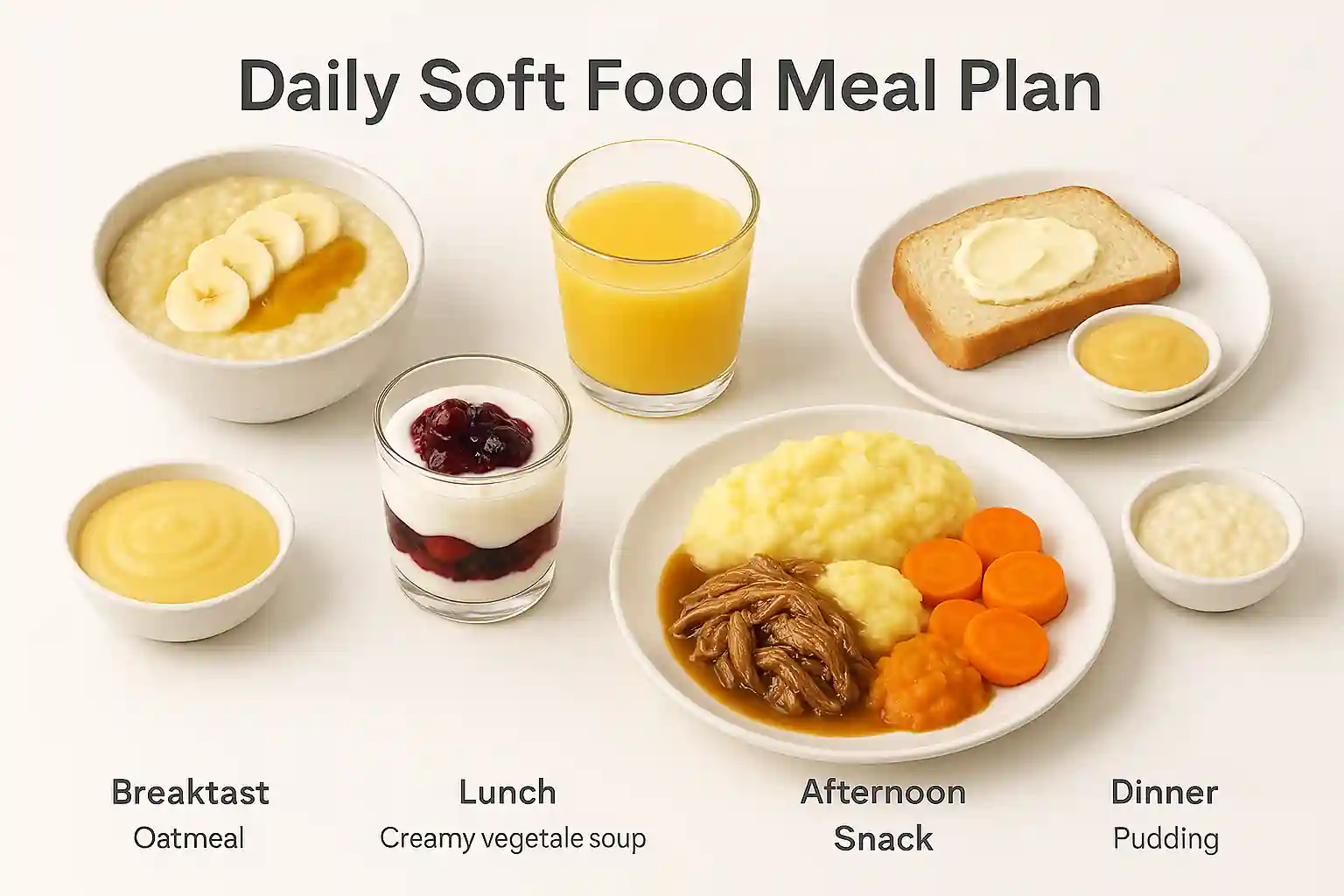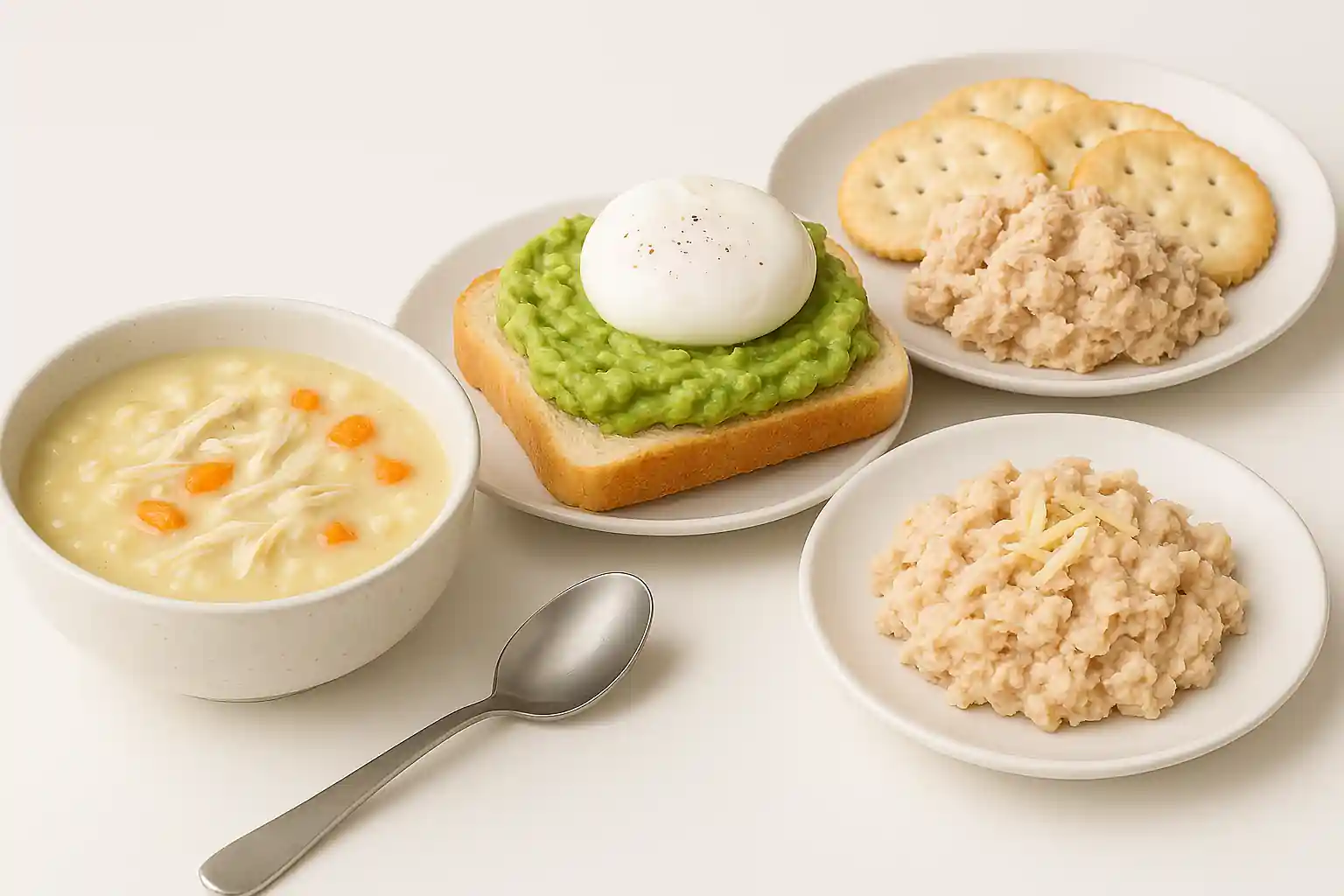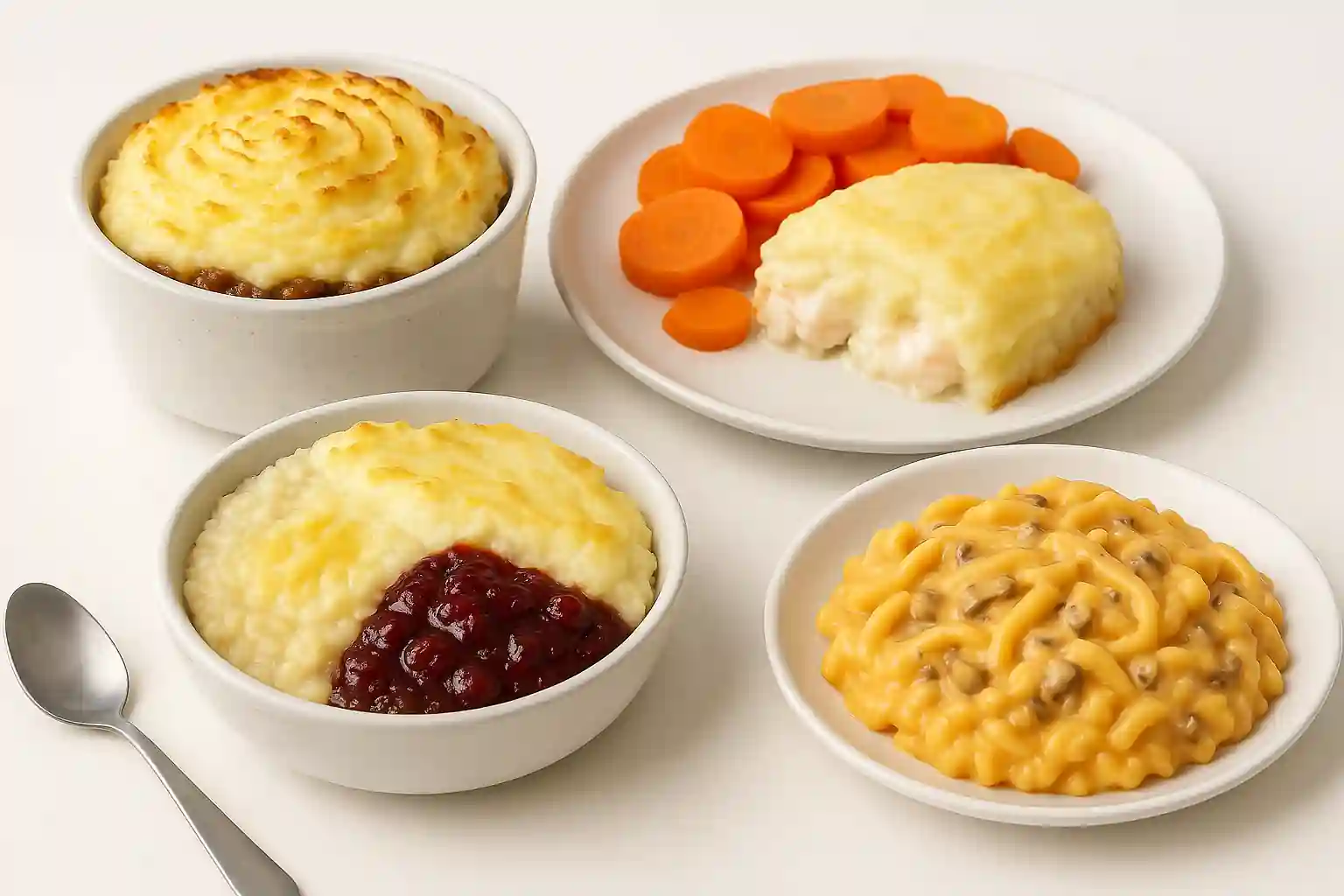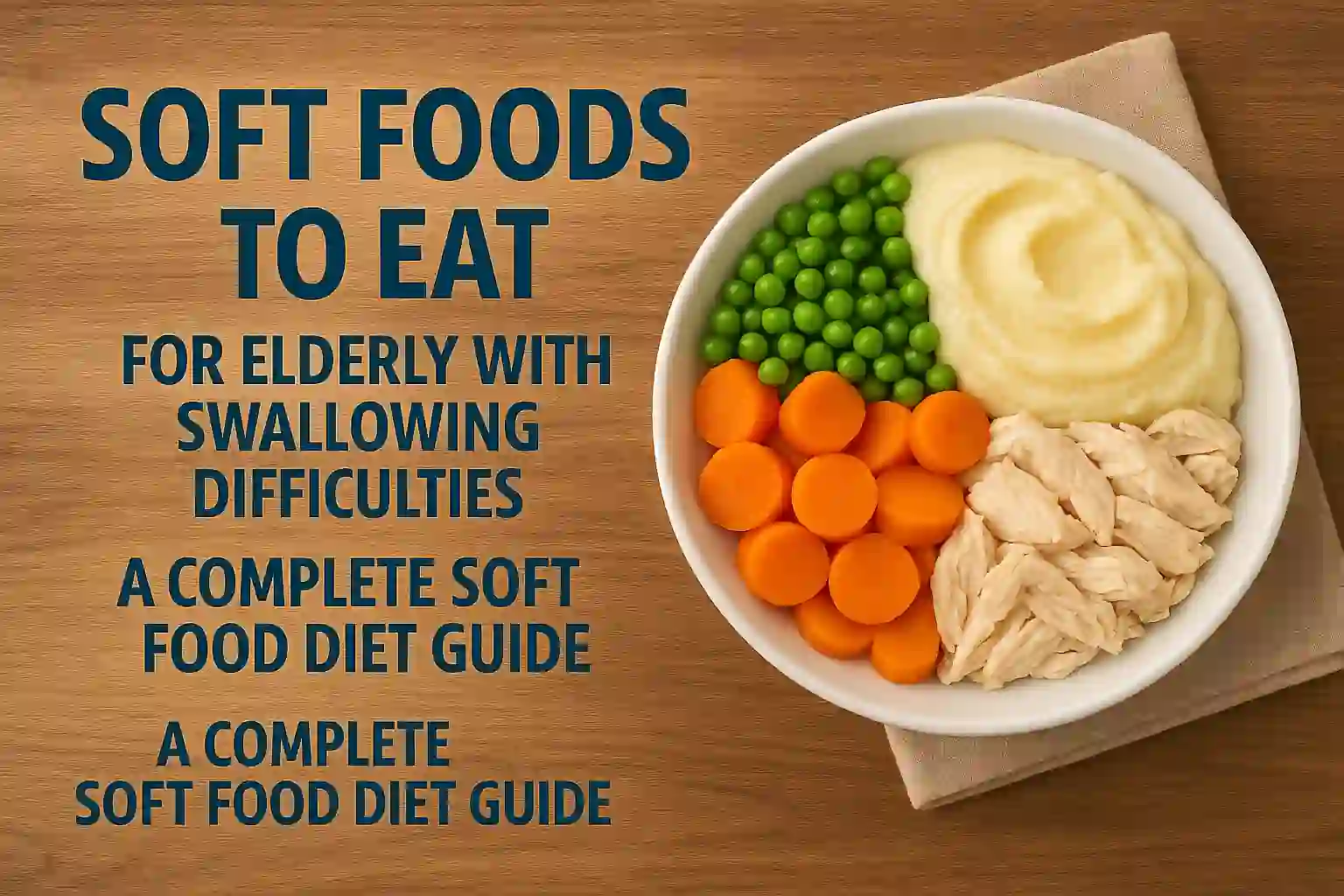Soft Foods to Eat for Elderly with Swallowing Difficulties: A Complete Soft Food Diet Guide
Eating should be enjoyable at every age, but for many elderly people, chewing and swallowing can become difficult due to dental issues, health conditions, or age-related changes. When this happens, following a soft food diet or a gastrointestinal soft diet can help ensure proper nutrition without the struggle of hard-to-chew foods.
This guide will help you understand what a soft diet is, which soft foods to eat, meal ideas, and how to create balanced meals for elderly people who have difficulty chewing and swallowing.
What Is a Soft Diet?
A soft diet, also called a gastrointestinal soft diet or soft food diet, is recommended for people who have problems with chewing and swallowing. Healthcare providers, dietitians, or speech and language therapists may suggest it for people recovering from dental surgery, elderly people with dental issues, or anyone with gastrointestinal or throat conditions.
A soft food diet includes foods that are easy to chew, swallow, and digest while providing the fibre and nutrients your body needs.
Who Needs a Soft Food Diet?
Soft diets are useful for:
- Elderly people with dental problems or dentures
- People recovering from dental surgery or mouth sores
- Patients following NHS guidelines for gastrointestinal conditions
- Those needing to avoid foods that are hard, crunchy, or high in fibre that’s tough to digest
Foods to Eat on a Soft Food Diet
Let’s break down the food groups and show what soft foods to eat for each:
Soft Fruit Options
Fruit is an important part of a balanced diet. For a soft diet, choose ripe or cooked fruits that don’t require much chewing.
Soft fruit ideas:
- Banana (ripe, sliced or mashed)
- Applesauce (no chunks)
- Stewed berries (like blueberry, strawberry)
- Ripe peach without skin
- Canned peaches or pears (in juice, not syrup)
- Melon without seeds
- You can mash fruits, blend them into smoothies, or cook them into a puree.
Soft Vegetables to Eat
Soft vegetables are important for fibre and nutrients. For elderly people, cooking vegetables until they’re tender makes them easy to swallow.
Soft vegetable ideas:
- Mashed potato with butter or cream
- Cooked carrot or squash
- Steamed green beans, finely chopped
- Pureed peas
- Tomato sauce or tomato paste
- Pumpkin mash
- Mushroom cooked and finely chopped
Adding gravy, cream, or butter makes them smoother and easier to chew.
Soft Meat and Protein Sources
Protein is key for strength and healing. For a soft food diet, meats must be tender and moist.
Soft meat meal ideas:
- Tender pulled pork with gravy
- Sausage cooked and finely chopped
- Soft lunch meats like thin-sliced turkey or chicken
- Ground beef cooked with sauce
- Fish fillet or tuna mixed with mayonnaise
- Poached eggs or soft omelette
Using a food processor can help prepare meats without a lot of chewing needed.
Soft Breads and Cereals
Soft bread and cereals provide energy and comfort.
Options include:
- White bread with crusts removed
- Pancakes with syrup or butter
- Soft muffins or moist cake
- Oatmeal or oatmeal with berries
- Cereal soaked in milk until soft
- Rice pudding or custard
Avoid breads with seeds or grains that can be hard to chew.
Soft Soups and Broths
Soups are perfect for a soft food diet. They’re easy to swallow and can be packed with nutrients.
Soup ideas:
- Creamy vegetable soup
- Tomato soup
- Chicken noodle soup with finely shredded meat
- Squash or pumpkin soup
- Mushroom soup
- Broth with rice or noodles
Blend chunky soups for smoother textures.
Soft Dairy and Desserts
Dairy products provide protein, calcium, and calories for those who may eat less.
Soft dairy options:
- Yogurt (plain or fruit)
- Cream or whipped cream
- Pudding or custard
- Soft cheese spreads
- Milkshakes or smoothies
Snacks for a Soft Diet
Snacks help keep energy up throughout the day.
Snack ideas:
- Applesauce cup
- Pudding cup
- Banana with yogurt
- Soft cheese with bread
- Mashed avocado with soft bread
How to Prepare Foods Without a Lot of Chewing
When preparing soft foods to eat, focus on moisture and smoothness:
- Cook foods until tender.
- Use sauces, gravy, or cream to add moisture.
- Use a food processor to puree meat, vegetables, or fruit.
- Serve foods warm to make swallowing easier.
- Use spices and herbs to add flavor without making the food hard to chew.
Daily Soft Food Meal Plan

Here’s a simple plan for an elderly person following a soft food diet.
Breakfast
- Oatmeal with mashed banana and a drizzle of syrup
- Soft scrambled eggs
- Glass of juice
Mid-Morning Snack
- Yogurt with stewed berries
Lunch
- Creamy vegetable soup
- Soft bread with soft cheese
- Applesauce
Afternoon Snack
- Pudding or custard
Dinner
- Tender pulled pork with mashed potato and gravy
- Cooked carrots and squash mash
- Rice pudding
Tips for a Balanced Soft Food Diet
- Include all food groups: fruit, vegetable, meat, dairy, and grains.
- Add fibre with soft vegetables, mashed beans, or pureed peas.
- Use a food processor to make tough foods softer.
- Ask a dietitian for supplement ideas if needed.
- Stay hydrated with juice, soup, or water.
Soft Foods to Eat for Dental Problems
Dental issues make chewing hard foods painful. Following a soft food diet helps protect teeth and gums.
Foods like mashed potato, soft pancakes, tender meats, and creamy soups are perfect for dental recovery. The NHS often recommends a gastrointestinal soft diet after dental surgery or treatment.
When to See a Dietitian or Speech Therapist
If you or your loved one has severe trouble chewing and swallowing, healthcare professionals like a dietitian or speech and language therapist can help. They can teach you how to follow a soft food diet safely, prevent choking, and keep meals nutritious.
Frequently Asked Questions
What is a soft food diet?
A soft food diet includes foods that are easy to chew and swallow. It’s used for people with dental problems, swallowing difficulties, or after surgery.
Is there an NHS guide for a gastrointestinal soft diet?
Yes, the NHS provides information for patients who need a soft diet due to digestive or dental issues. Always follow your healthcare provider’s advice.
How do I make meat soft enough to eat?
Use tender cuts, cook slowly, add gravy, or shred meat finely. Use a food processor for extra softness.
Can you add fibre on a soft food diet?
Yes, choose soft vegetables, mashed beans, or pureed peas. A dietitian can suggest supplements if needed.
Final Thoughts
A soft food diet can help elderly people get the nutrition they need while avoiding discomfort when chewing and swallowing. With the right meal ideas, gentle cooking methods, and guidance from healthcare providers, you can make sure every meal is tasty, nutritious, and easy to enjoy.
Soft Food Diet Recipes to Try
Creamy Potato Soup
Combine mashed potato, cream, and broth. Blend until smooth.
Tender Pulled Pork
Slow-cook pork shoulder with mild spices and broth. Shred finely and serve with soft bread.
Banana Custard
Mash ripe banana and mix with ready-made custard for a soft, sweet dessert.
Final Tips for Caregivers
-
Always check food textures before serving.
-
Keep meals moist — add gravy or sauce.
-
Serve foods warm, not too hot.
-
Follow NHS or dietitian advice.
-
Monitor weight and nutrition levels.
-
Talk to a speech and language therapist if swallowing gets worse.
More Easy Soft Food Recipes for Elderly
Adding variety keeps a soft food diet tasty and enjoyable. Here are more soft meal ideas and recipes for breakfast, lunch, dinner, and snacks.
Soft Breakfast Ideas

1. Creamy Oatmeal with Fruit
- Cook oats in milk for extra creaminess.
- Top with mashed ripe banana, stewed berries, or applesauce.
- Add a drizzle of syrup or honey if allowed.
2. Soft Pancakes
- Make fluffy pancakes with extra milk for softness.
- Top with whipped cream or soft fruit puree.
- Avoid nuts or hard toppings.
3. Scrambled Eggs with Cheese
- Cook scrambled eggs until soft and fluffy.
- Add a spoonful of cream cheese or shredded soft cheese for extra moisture.
Easy Soft Lunches

1. Creamy Chicken Soup
- Slow-cook chicken breast until tender.
- Shred finely and mix into creamy chicken broth.
- Add cooked carrots or peas, mashed.
2. Mashed Avocado Toast
- Use soft, crustless bread.
- Mash ripe avocado with a little salt.
- Top with soft poached egg if desired.
3. Tuna or Salmon Salad
- Mix canned tuna or salmon with mayo or yogurt.
- Serve on soft bread or with soft crackers.
Hearty Soft Dinners

1. Shepherd’s Pie
- Cook ground beef or lamb until soft.
- Layer with mashed potato and soft peas.
- Bake until heated through.
2. Fish Pie
- Use soft white fish cooked in milk.
- Add mashed potato topping.
- Serve with soft cooked carrots.
3. Creamy Pasta
- Cook pasta until very soft.
- Mix with creamy sauce or mild tomato sauce.
- Add finely chopped tender mushrooms.
Dessert Recipes for a Soft Diet

Desserts help add calories and pleasure.
1. Smooth Banana Pudding
- Mash ripe bananas.
- Fold into store-bought or homemade vanilla pudding.
2. Berry Yogurt Parfait
- Layer stewed berries with plain yogurt.
- Add soft custard for extra richness.
3. Soft Baked Custard
- Make custard with eggs, milk, and a bit of vanilla.
- Bake until soft and creamy — no crust needed.
Weekly Soft Food Meal Plan
Monday
- Breakfast: Creamy oatmeal with mashed banana
- Lunch: Creamy vegetable soup with soft bread
- Dinner: Pulled pork with mashed potato and gravy
- Snacks: Yogurt cup, applesauce
Tuesday
- Breakfast: Soft pancakes with syrup
- Lunch: Tuna salad on soft bread
- Dinner: Fish pie with soft peas
- Snacks: Banana custard, pudding cup
Wednesday
- Breakfast: Scrambled eggs with soft toast
- Lunch: Creamy chicken soup with mashed squash
- Dinner: Shepherd’s pie
- Snacks: Berry yogurt, mashed avocado toast
… and so on for the full week. You can repeat meals or mix recipes to suit taste and budget.
Supplements and Nutrition Tips
If it’s hard to eat enough on a soft food diet, adding supplements can help:
- Use protein powder in smoothies.
- Add powdered milk to soups or mashed potatoes.
- Use full-fat yogurt for extra calories.
- Talk to a dietitian for personalized advice.
Kitchen Tools That Make Soft Foods Easier
Good tools can make prep easier:
Food processor: Purees meat, vegetables, and fruit.
Blender: For smoothies, soups, and purees.
Fine mesh sieve: To strain out tough bits.
Slow cooker: Makes meat tender and moist.
Shopping List for a Soft Food Diet
Staples:
- Ripe fruit (bananas, peaches, berries)
- Applesauce
- White bread, pancakes, muffins
- Mashed potato mix
- Eggs
- Full-fat yogurt
- Custard or pudding cups
- Canned soft meats (tuna, salmon)
- Ground meat
- Soft cheese
- Butter, cream, gravy packets
FAQs About Soft Food Diets
Can you follow a soft food diet long-term?
Yes, with the help of a dietitian to balance nutrients. Sometimes it’s temporary; other times, it’s needed long-term for safety.
How to make sure the diet has enough fibre?
Use soft vegetables, pureed beans, and cooked fruits. If needed, a dietitian might recommend fibre supplements.
Is a soft diet safe for diabetics?
Yes — but be mindful of sugar in custards, puddings, and fruit. Choose plain yogurt and unsweetened applesauce when possible.
Can I use spices?
Yes! Mild spices and herbs like parsley, thyme, or cinnamon can add flavor without affecting softness.
What should I avoid on a soft food diet?
- Tough meats, raw vegetables, crusty bread
- Seeds, nuts, popcorn
- Crispy or fried foods that are hard to chew
Tips for Caregivers: Make Eating Easier
-
Serve small meals more often.
-
Sit upright during meals.
-
Allow plenty of time to eat — don’t rush.
-
Keep a drink handy to help with swallowing.
-
Talk to a speech therapist for advanced swallowing issues.
Final Words
Following a soft food diet for elderly people with swallowing difficulties can dramatically improve comfort and nutrition. By choosing the right soft foods to eat, preparing them well, and offering variety, you help maintain health, dignity, and enjoyment at mealtime.
Always consult your healthcare provider or NHS resources for personalized advice on a gastrointestinal soft diet or dental soft food plan.
Extra Easy Soft Snacks for Elderly with Swallowing Difficulties
Snacks keep energy up and add variety to a soft food diet. Here are more gentle snack ideas:
- Soft boiled eggs mashed with a little mayo.
- Smooth hummus with soft white bread triangles (no crust).
- Cream cheese on soft pancakes or muffins.
- Cottage cheese with soft peaches.
- Soft banana bread, no nuts, with butter.
- Blended fruit smoothies with protein powder.
- Soft custard topped with berry puree.
- Rice pudding with cinnamon.
- Creamy mashed avocado with a spoon.
- Warm applesauce with a drizzle of honey.
Full 7-Day Soft Food Meal Plan
Here’s a practical sample meal plan you can offer as a downloadable or printable for caregivers and families.
| Day | Breakfast | Lunch | Dinner | Snacks |
|---|---|---|---|---|
| Monday | Oatmeal with mashed banana | Creamy vegetable soup with soft bread | Pulled pork with mashed potato | Yogurt cup, applesauce |
| Tuesday | Soft pancakes with syrup | Tuna salad on soft bread | Fish pie with soft peas | Banana custard, pudding cup |
| Wednesday | Scrambled eggs with soft toast | Creamy chicken soup with mashed squash | Shepherd’s pie | Berry yogurt, mashed avocado |
| Thursday | Soft muffins with butter | Tomato soup with soft bread | Creamy pasta with mushrooms | Rice pudding, soft banana bread |
| Friday | Creamy oatmeal with stewed berries | Mashed avocado toast with poached egg | Tender pulled pork with gravy | Custard cup, soft boiled egg |
| Saturday | Pancakes with berry puree | Chicken noodle soup with soft bread | Fish fillet with mashed peas | Smoothie, cottage cheese with peaches |
| Sunday | Scrambled eggs with soft muffin | Mushroom soup with mashed potato | Ground beef with mashed sweet potato | Applesauce, soft pancake with cream cheese |
Budget Tips for a Soft Food Diet
A soft food diet doesn’t have to be expensive. Here’s how to shop smart:
✅ Buy ripe seasonal fruits — softer and cheaper.
✅ Use canned fruit in juice (not syrup) for easy purees.
✅ Choose store-brand yogurt, pudding, and custard to save money.
✅ Buy bulk oats and rice for porridge and pudding.
✅ Use affordable cuts like ground meat or pork shoulder, cook slowly until tender.
✅ Make big batches of soup and freeze in small portions.
✅ Add powdered milk or protein powder for extra nutrition without extra cost.
Shopping List For You
Create a simple printable list for readers. Example:
Soft Food Diet Grocery List
Fruits
- Bananas (ripe)
- Applesauce
- Berries (fresh or frozen)
- Canned peaches, pears
Vegetables
- Potatoes
- Carrots
- Squash
- Peas
- Mushrooms
- Tomato paste/sauce
Protein
- Eggs
- Soft lunch meats
- Ground beef/pork
- Fish fillets (white fish)
- Tuna/salmon cans
- Cottage cheese, soft cheese
Grains & Bread
- White bread (no crust)
- Muffins, pancakes
- Oatmeal
- Rice
Dairy & Extras
- Yogurt (plain or flavored)
- Pudding or custard
- Cream, butter
- Protein powder
- Broth or stock
Pro Tips for Caregivers: Supporting Chewing & Swallowing
✔️ Encourage slow eating — small bites, time to swallow.
✔️ Sit upright at meals — helps prevent choking.
✔️ Keep meals moist — use gravy, broth, cream sauces.
✔️ If in doubt, use a food processor to blend foods finer.
✔️ Store blended leftovers in small containers for quick meals.
✔️ Add flavor with mild herbs and spices — gentle on the stomach.
✔️ Work with a speech and language therapist for advanced swallowing problems.
More FAQs
What if they can’t tolerate dairy?
Try non-dairy alternatives: soy yogurt, almond milk, or dairy-free custard. Check with a dietitian for protein needs.
Can you freeze soft meals?
Yes! Most soups, mashed dishes, and purees freeze well. Thaw gently and reheat until warm.
Is it safe to eat store-bought soft desserts?
Yes, but watch sugar if diabetes is a concern. Unsweetened applesauce or plain yogurt are good options.
Conclusion: Gentle, Nourishing, and Full of Care
A soft food diet is more than just mashed potatoes. It’s about comfort, nutrition, and dignity for elderly people who struggle with chewing and swallowing. With the right foods to eat, creative meal ideas, easy recipes, and help from healthcare providers like dietitians and speech and language therapists, families can support loved ones every day.
Final Encouragement
Remember:
- Follow medical advice — each person’s swallowing needs are different.
- Keep meals tasty and varied.
- Be patient — eating slowly makes it safer and more enjoyable.
- Stay positive — good food can still be comforting and delicious!

